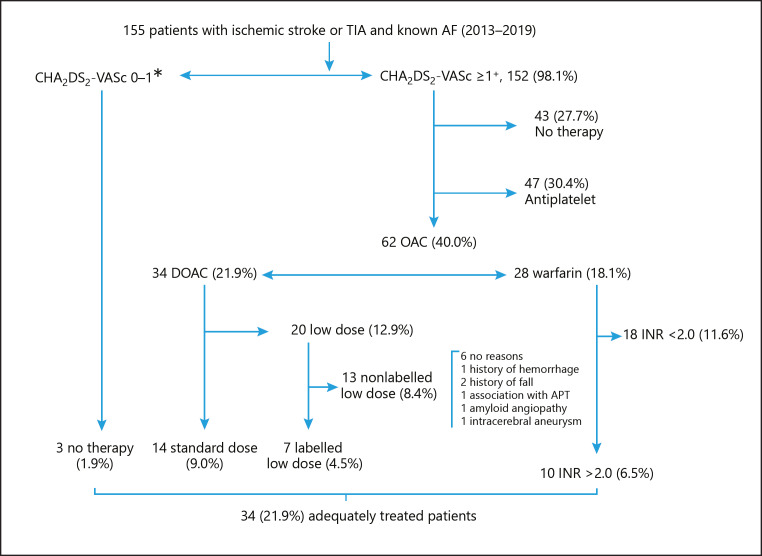已知房颤患者卒中前抗凝治疗的比率和决定因素。
IF 2
Q3 PERIPHERAL VASCULAR DISEASE
引用次数: 5
摘要
前言和目的:尽管较少麻烦的抗凝药物的引入已经有所改善,但符合条件的房颤(AF)患者的总体抗凝治疗率仍有待确定。我们的目的是评估自临床实践中引入直接口服抗凝剂(DOAC)以来已知房颤患者卒中前抗凝治疗的使用率和决定因素。方法:从2013年9月到2019年7月,连续入院的急性缺血性卒中或短暂性缺血性发作(TIA)患者在事件发生前已知房颤。采用Logistic回归分析确定抗凝治疗使用的独立预测因素。结果:本研究共纳入155例缺血性卒中/TIA和已知AF患者。在152例CHA2DS2-VASc评分>1的患者中,43例患者未接受任何治疗,47例患者接受抗血小板药物治疗,其余62例患者接受口服抗凝药物治疗。在34名服用DOAC的患者中,13名患者接受了未标记的减少剂量,34名服用维生素K拮抗剂的患者中有18名患者的INR值。结论:只有21.9%的因卒中或TIA住院的患者在事件发生前已知AF,根据最近的治疗指南得到了充分的治疗。提高房颤风险和抗凝剂在卒中预防中的疗效的医学信息是很重要的。本文章由计算机程序翻译,如有差异,请以英文原文为准。

Rates and Determinants for the Use of Anticoagulation Treatment before Stroke in Patients with Known Atrial Fibrillation.
Introduction and Objective: Even though the introduction of less cumbersome anticoagulant agents has improved, the rates ofoverall anticoagulant treatment in eligible patients with atrial fibrillation (AF) remain to be defined. We aimed to assess the rates of and determinants for the use of anticoagulation treatment before stroke in patients with known AF since the introduction of direct oral anticoagulants (DOAC) in clinical practice. Methods: Consecutive patients admitted to an individual stroke unit, from September 2013 through July 2019, for acute ischemic stroke or transient ischemic attack (TIA) with known AF before the event were included in the study. Logistic regression analysis was used to identify independent predictors of the use of anticoagulant treatment. Results: Overall, 155 patients with ischemic stroke/TIA and known AF were included in this study. Among 152 patients with a CHA2DS2-VASc score >1, 43 patients were not receiving any treatment, 47 patients were receiving antiplatelet agents, and the remaining 62 patients were on oral anticoagulants. Among 34 patients on DOAC, 13 were receiving a nonlabeled reduced dose and 18 out of 34 patients on vitamin K antagonists had an INR value <2 at the time of admission. Before stroke, only 34 out of 155 patients (21.9%) were adequately treated according to current guidelines. Previous stroke/TIA was the only independent predictor of the use of anticoagulant therapy. Conclusions: Only 21.9% of the patients hospitalized for a stroke or TIA with known AF before the event were adequately treated according to recent treatment guidelines. It is important to improve medical information about the risk of AF and the efficacy of anticoagulants in stroke prevention.
求助全文
通过发布文献求助,成功后即可免费获取论文全文。
去求助
来源期刊

Cerebrovascular Diseases Extra
PERIPHERAL VASCULAR DISEASE-
CiteScore
3.50
自引率
0.00%
发文量
16
审稿时长
8 weeks
期刊介绍:
This open access and online-only journal publishes original articles covering the entire spectrum of stroke and cerebrovascular research, drawing from a variety of specialties such as neurology, internal medicine, surgery, radiology, epidemiology, cardiology, hematology, psychology and rehabilitation. Offering an international forum, it meets the growing need for sophisticated, up-to-date scientific information on clinical data, diagnostic testing, and therapeutic issues. The journal publishes original contributions, reviews of selected topics as well as clinical investigative studies. All aspects related to clinical advances are considered, while purely experimental work appears only if directly relevant to clinical issues. Cerebrovascular Diseases Extra provides additional contents based on reviewed and accepted submissions to the main journal Cerebrovascular Diseases.
 求助内容:
求助内容: 应助结果提醒方式:
应助结果提醒方式:


